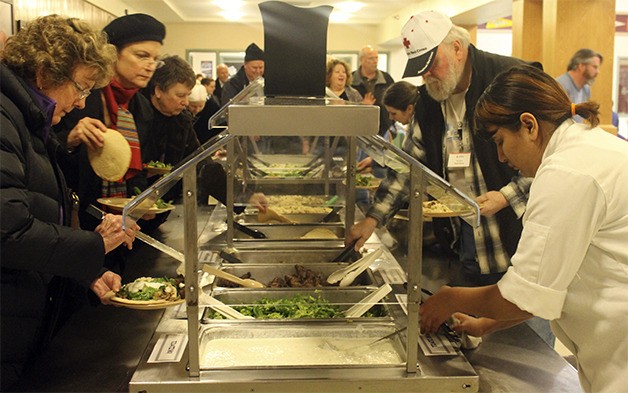The smells from large batches of homemade food wafts beyond the high school grounds. Students clad in chef coats and aprons rush around to put the finishing touches on the dishes that will feed hundreds of community members. The head chef rings the bell and the line queued up out the door is ushered to the buffet-style bar. Dinner is served.
“If you want to learn how to cook take culinary,” said Liz Varvaro, San Juan Island School District food service supervisor and teacher. “If you want to learn how to work take chef.”
Semi-monthly community dinners are hosted to showcase “Food for Thought,” a program started in 2008 to bring hearty, healthy, from scratch meals to the district’s students and faculty. Varvaro works side by side with Executive Chef Andrew Radzialowski, better known as “Chef Andy.” Together the two run a tight ship.
Varvaro isn’t your typical lunch lady, and her kitchen not your typical classroom. She’s the teacher of Chef 1.0, a work-based learning “student chef internship.” From prep to cleanup, the program teaches high school students how to work in a commercial kitchen.
Students leave the program with the skills needed to work in the food-service industry, oftentimes starting above minimum wage because they already know the industry standards.
Many students are able to find well-paid summer jobs in the local workforce, while others go on to continue their education in culinary school and have careers in the food industry.
Senior Summer Fields’ time in the kitchen during high school has given her the confidence she needs to pursue her goals in college. She will go on to the culinary program at Bellingham Tech after she graduates in the spring.
“This program helped a lot,” she said. “It showed me I can actually do it.”
Jafet Soto, a junior, spends his summers working for Friday Harbor restaurants Backdoor Kitchen and The Golden Triangle. Thanks to the program, Soto also found his niche.
“I want to keep working in the kitchen,” he said.
During any given school year you’ll find about 20 students enrolled in Chef 1.0. The students learn in real time, as the school kitchen needs to get the food prepared and cooked for the day ahead. While sometimes the students get to aid in developing different recipes for sauces and dressings, they mostly spend their time prepping food, putting away stock, cleaning and sanitizing.
While it initially takes time and effort to train the students to work safely and efficiently, once they get the hang of things they’re a great benefit to the kitchen. Because there are students available to help chop, season, and store the food, the school doesn’t need to buy processed or frozen foods to keep up with demand, Vavaro said.
If a student is involved in a cooking class like Culinary 1.0, the class requires them to spend one full week in Varvaro’s kitchen.
“They’re either scared and never want to come back, or they’re excited,” she said. “It’s a big job feeding the district.”
If a culinary student then wants to enroll in the work-based program, they must interview for the position as if it were a job, because that’s how Varvaro runs the program. When students arrive at the kitchen it’s as if they’ve left school and arrived at work.
Seven years ago, when the school’s food services was operating at a deficit, the kitchen was in danger of being shut down. Radzialowski and Varvaro put their heads together to come up with the Food for Thought program, with the goal to bring fresh, hearty and healthy food to the district’s children. Thanks to many strong parents and community members, as well as a grant to get the program up and running, Food for Thought was born.
Since then lunch sales have gone up and truancy post lunch has gone down because many students remain on campus for lunch, Varvaro said.
Varvaro is not only tasked with training teenagers to be workforce ready and feeding the district, but keeping food services fiscally viable. The community dinners also help offset some of costs of the program, like buying extra knives and chef coats. The next community dinner is tentatively scheduled for March 11.
Above all the program is a break from the norm that offers an alternative classroom environment, and farm to table choices in a country becoming increasingly disconnected from it’s food.
“Those that struggle and those with a 4.00 are elbow to elbow chopping the same bag of onions,” she said. “It’s a great equalizer.”



